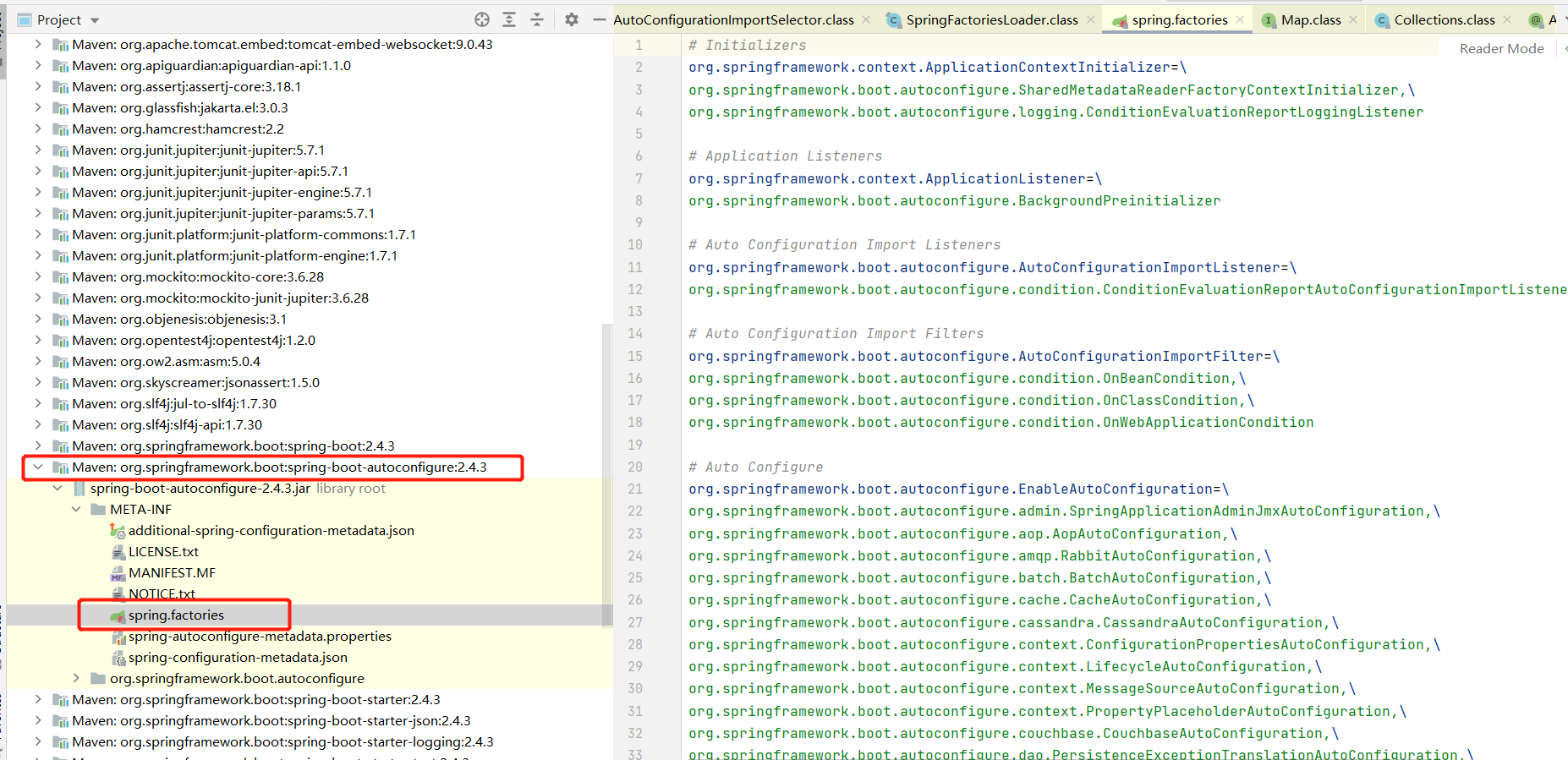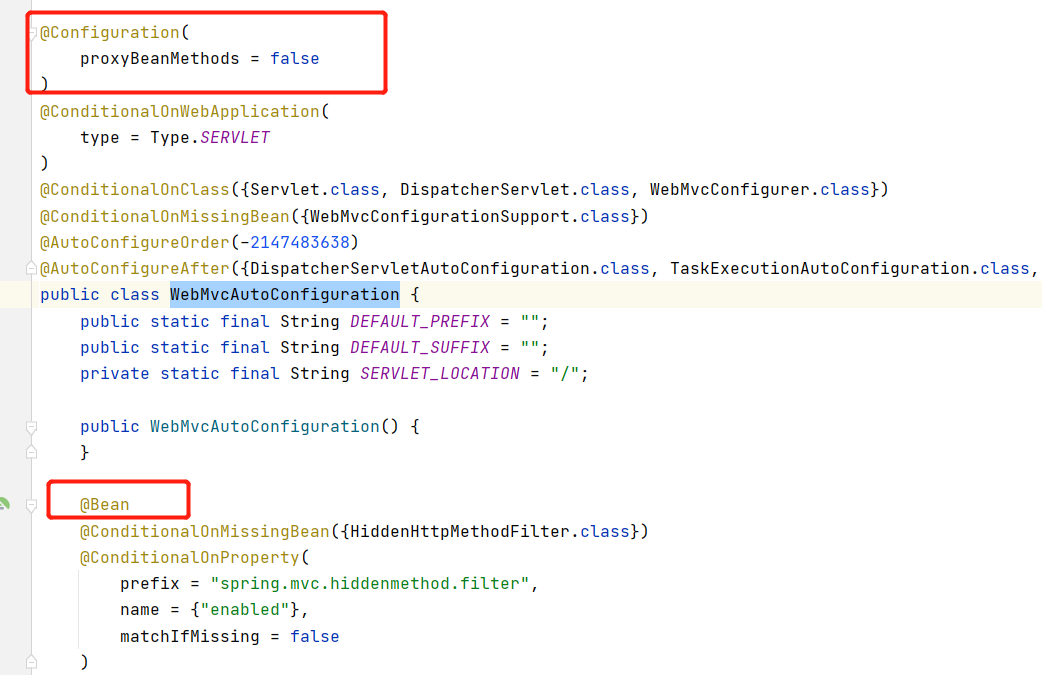SpringBoot-03 pom文件及主启动类分析
pom.xml配置文件
父依赖
其中它主要是依赖一个父项目,主要是管理项目的资源过滤及插件!
<parent>
<groupId>org.springframework.boot</groupId>
<artifactId>spring-boot-starter-parent</artifactId>
<version>2.4.3</version>
<relativePath/> <!-- lookup parent from repository -->
</parent>
点进去,还有一层父依赖
<parent>
<groupId>org.springframework.boot</groupId>
<artifactId>spring-boot-dependencies</artifactId>
<version>2.4.3</version>
</parent>
这里才是真正管理SpringBoot应用里面所有依赖版本的地方,SpringBoot的版本控制中心;
<?xml version="1.0" encoding="UTF-8"?> <project xmlns="http://maven.apache.org/POM/4.0.0" xsi:schemaLocation="http://maven.apache.org/POM/4.0.0 http://maven.apache.org/xsd/maven-4.0.0.xsd" xmlns:xsi="http://www.w3.org/2001/XMLSchema-instance"> <modelVersion>4.0.0</modelVersion> <groupId>org.springframework.boot</groupId> <artifactId>spring-boot-dependencies</artifactId> <version>2.4.3</version> <packaging>pom</packaging> <name>spring-boot-dependencies</name> <description>Spring Boot Dependencies</description> <url>https://spring.io/projects/spring-boot</url> <licenses> <license> <name>Apache License, Version 2.0</name> <url>https://www.apache.org/licenses/LICENSE-2.0</url> </license> </licenses> <developers> <developer> <name>Pivotal</name> <email>info@pivotal.io</email> <organization>Pivotal Software, Inc.</organization> <organizationUrl>https://www.spring.io</organizationUrl> </developer> </developers> <scm> <url>https://github.com/spring-projects/spring-boot</url> </scm> <properties> <activemq.version>5.16.1</activemq.version> ... 依赖、插件版本号管理 </properties> <dependencyManagement> <dependencies> <dependency> <groupId>org.apache.activemq</groupId> <artifactId>activemq-amqp</artifactId> <version>${activemq.version}</version> </dependency> ... 依赖管理 </dependencies> </dependencyManagement> <build> <pluginManagement> <plugins> <plugin> <groupId>org.codehaus.mojo</groupId> <artifactId>build-helper-maven-plugin</artifactId> <version>${build-helper-maven-plugin.version}</version> </plugin> ... 插件管理 </plugins> </pluginManagement> </build> </project>
以后我们导入依赖默认是不需要写版本;但是如果导入的包没有在依赖中管理着就需要手动配置版本了;
启动器 spring-boot-starter
<!--web场景启动器-->
<dependency>
<groupId>org.springframework.boot</groupId>
<artifactId>spring-boot-starter-web</artifactId>
</dependency>
<!--单元测试用-->
<dependency>
<groupId>org.springframework.boot</groupId>
<artifactId>spring-boot-starter-test</artifactId>
<scope>test</scope>
</dependency>
springboot-boot-starter-xxx:就是spring-boot的场景启动器
spring-boot-starter-web:帮我们导入了web模块正常运行所依赖的组件;
SpringBoot将所有的功能场景都抽取出来,做成一个个的starter (启动器),只需要在项目中引入这些starter即可,所有相关的依赖都会导入进来 , 我们要用什么功能就导入什么样的场景启动器即可 ;我们未来也可以自己自定义 starter;
项目运行时,根据配置的启动器,读取运行相关的配置文件。
主启动类
import org.springframework.boot.SpringApplication; import org.springframework.boot.autoconfigure.SpringBootApplication; @SpringBootApplication public class HelloworldApplication { public static void main(String[] args) { SpringApplication.run(HelloworldApplication.class, args); } }
@SpringBootApplication:
来标注一个主程序类,说明这是一个Spring Boot应用
作用:标注在某个类上说明这个类是SpringBoot的主配置类 , SpringBoot就应该运行这个类的main方法来启动SpringBoot应用;
点击进入该注解,查看其延申注解:
package org.springframework.boot.autoconfigure; import java.lang.annotation.Documented; import java.lang.annotation.ElementType; import java.lang.annotation.Inherited; import java.lang.annotation.Retention; import java.lang.annotation.RetentionPolicy; import java.lang.annotation.Target; import org.springframework.beans.factory.support.BeanNameGenerator; import org.springframework.boot.SpringBootConfiguration; import org.springframework.boot.context.TypeExcludeFilter; import org.springframework.context.annotation.ComponentScan; import org.springframework.context.annotation.Configuration; import org.springframework.context.annotation.FilterType; import org.springframework.context.annotation.ComponentScan.Filter; import org.springframework.core.annotation.AliasFor; @Target({ElementType.TYPE}) @Retention(RetentionPolicy.RUNTIME) @Documented @Inherited @SpringBootConfiguration @EnableAutoConfiguration @ComponentScan( excludeFilters = {@Filter( type = FilterType.CUSTOM, classes = {TypeExcludeFilter.class} ), @Filter( type = FilterType.CUSTOM, classes = {AutoConfigurationExcludeFilter.class} )} ) public @interface SpringBootApplication { @AliasFor( annotation = EnableAutoConfiguration.class ) Class<?>[] exclude() default {}; @AliasFor( annotation = EnableAutoConfiguration.class ) String[] excludeName() default {}; @AliasFor( annotation = ComponentScan.class, attribute = "basePackages" ) String[] scanBasePackages() default {}; @AliasFor( annotation = ComponentScan.class, attribute = "basePackageClasses" ) Class<?>[] scanBasePackageClasses() default {}; @AliasFor( annotation = ComponentScan.class, attribute = "nameGenerator" ) Class<? extends BeanNameGenerator> nameGenerator() default BeanNameGenerator.class; @AliasFor( annotation = Configuration.class ) boolean proxyBeanMethods() default true; }
@Target({ElementType.TYPE})--------target主要是声明一个新的注解,自定义一个新的注解,target后面是新注解的范围
@Retention(RetentionPolicy.RUNTIME)--------用来修饰注解,是注解的注解,称为元注解。
@Documented--------表明这个注解应该被 javadoc工具记录
@Inherited--------表示该注解会被子类继承,注意,仅针对类,成员属性、方法并不受此注释的影响。
@ComponentScan--------
- 这个注解在Spring中很重要 ,它对应XML配置中的元素。
- 作用:自动扫描并加载符合条件的组件或者bean , 将这个bean定义加载到IOC容器中
@SpringBootConfiguration--------
作用:SpringBoot的配置类 ,标注在某个类上 , 表示这是一个SpringBoot的配置类;
点击@SpringBootConfiguration进入
@Documented @Configuration public @interface SpringBootConfiguration { @AliasFor( annotation = Configuration.class ) boolean proxyBeanMethods() default true; }
点击@Configuration进入
@Component public @interface Configuration { @AliasFor( annotation = Component.class ) String value() default ""; boolean proxyBeanMethods() default true; }
上面的 @Configuration,说明这是一个配置类 ,配置类就是对应Spring的xml 配置文件;
下面的 @Component 这就说明,启动类本身也是Spring中的一个组件而已,负责启动应用!
@EnableAutoConfiguration--------开启自动配置功能
以前我们需要自己配置的东西,而现在SpringBoot可以自动帮我们配置 ;@EnableAutoConfiguration告诉SpringBoot开启自动配置功能,这样自动配置才能生效;
点击进入
@AutoConfigurationPackage @Import({AutoConfigurationImportSelector.class}) public @interface EnableAutoConfiguration { String ENABLED_OVERRIDE_PROPERTY = "spring.boot.enableautoconfiguration"; Class<?>[] exclude() default {}; String[] excludeName() default {}; }
@AutoConfigurationPackage :自动配置包
@Import({Registrar.class})
public @interface AutoConfigurationPackage {
String[] basePackages() default {};
Class<?>[] basePackageClasses() default {};
}
@import :Spring底层注解@import , 给容器中导入一个组件
Registrar.class 作用:将主启动类的所在包及包下面所有子包里面的所有组件扫描到Spring容器 ;
static class Registrar implements ImportBeanDefinitionRegistrar, DeterminableImports { Registrar() { } public void registerBeanDefinitions(AnnotationMetadata metadata, BeanDefinitionRegistry registry) { AutoConfigurationPackages.register(registry, (String[])(new AutoConfigurationPackages.PackageImports(metadata)).getPackageNames().toArray(new String[0])); } public Set<Object> determineImports(AnnotationMetadata metadata) { return Collections.singleton(new AutoConfigurationPackages.PackageImports(metadata)); } }
@Import({AutoConfigurationImportSelector.class})--给容器导入组件 ;
AutoConfigurationImportSelector :自动配置导入选择器,那么它会导入哪些组件的选择器呢?我们点击去这个类看源码:
1、这个类中有一个这样的方法--取得候选配置
protected List<String> getCandidateConfigurations(AnnotationMetadata metadata, AnnotationAttributes attributes) {
//这里的getSpringFactoriesLoaderFactoryClass()方法
//返回的就是我们最开始看的启动自动导入配置文件的注解类;EnableAutoConfiguration List<String> configurations = SpringFactoriesLoader.loadFactoryNames(this.getSpringFactoriesLoaderFactoryClass(), this.getBeanClassLoader()); Assert.notEmpty(configurations, "No auto configuration classes found in META-INF/spring.factories.
If you are using a custom packaging, make sure that file is correct."); return configurations; }
protected Class<?> getSpringFactoriesLoaderFactoryClass() {
return EnableAutoConfiguration.class;
}
2、这个方法又调用了 SpringFactoriesLoader 类的静态方法!我们进入SpringFactoriesLoader类loadFactoryNames() 方法
public static List<String> loadFactoryNames(Class<?> factoryType, @Nullable ClassLoader classLoader) { ClassLoader classLoaderToUse = classLoader; if (classLoader == null) { classLoaderToUse = SpringFactoriesLoader.class.getClassLoader(); } //这里它又调用了 loadSpringFactories 方法 String factoryTypeName = factoryType.getName(); return (List)loadSpringFactories(classLoaderToUse).getOrDefault(factoryTypeName, Collections.emptyList()); }
3、我们继续点击查看SpringFactoriesLoader的loadSpringFactories 方法
private static Map<String, List<String>> loadSpringFactories(ClassLoader classLoader) {
//获得classLoader , 我们返回可以看到这里得到的就是EnableAutoConfiguration标注的类本身 Map<String, List<String>> result = (Map)cache.get(classLoader); if (result != null) { return result; } else { HashMap result = new HashMap(); try {
//去获取一个资源 "META-INF/spring.factories" Enumeration urls = classLoader.getResources("META-INF/spring.factories"); //将读取到的资源遍历,封装成为一个Properties while(urls.hasMoreElements()) { URL url = (URL)urls.nextElement(); UrlResource resource = new UrlResource(url); Properties properties = PropertiesLoaderUtils.loadProperties(resource); Iterator var6 = properties.entrySet().iterator(); while(var6.hasNext()) { Entry<?, ?> entry = (Entry)var6.next(); String factoryTypeName = ((String)entry.getKey()).trim(); String[] factoryImplementationNames = StringUtils.commaDelimitedListToStringArray((String)entry.getValue()); String[] var10 = factoryImplementationNames; int var11 = factoryImplementationNames.length; for(int var12 = 0; var12 < var11; ++var12) { String factoryImplementationName = var10[var12]; ((List)result.computeIfAbsent(factoryTypeName, (key) -> { return new ArrayList(); })).add(factoryImplementationName.trim()); } } } result.replaceAll((factoryType, implementations) -> { return (List)implementations.stream().distinct().collect(Collectors.collectingAndThen(Collectors.toList(), Collections::unmodifiableList)); }); cache.put(classLoader, result); return result; } catch (IOException var14) { throw new IllegalArgumentException("Unable to load factories from location [META-INF/spring.factories]", var14); } } }
4、发现一个多次出现的文件:spring.factories,全局搜索它
我们根据源头打开spring.factories , 看到了很多自动配置的文件;这就是自动配置根源所在!

WebMvcAutoConfiguration
我们在上面的自动配置类随便找一个打开看看,比如 :WebMvcAutoConfiguration

可以看到这些一个个的都是JavaConfig配置类,而且都注入了一些Bean,可以找一些自己认识的类,看着熟悉一下!
所以,自动配置真正实现是从classpath中搜寻所有的META-INF/spring.factories配置文件 ,并将其中对应的 org.springframework.boot.autoconfigure. 包下的配置项,通过反射实例化为对应标注了 @Configuration的JavaConfig形式的IOC容器配置类 , 然后将这些都汇总成为一个实例并加载到IOC容器中。
结论:
-
SpringBoot在启动的时候从类路径下的META-INF/spring.factories中获取EnableAutoConfiguration指定的值
-
将这些值作为自动配置类导入容器 , 自动配置类就生效 , 帮我们进行自动配置工作;
-
整个J2EE的整体解决方案和自动配置都在springboot-autoconfigure的jar包中;
-
它会给容器中导入非常多的自动配置类 (xxxAutoConfiguration), 就是给容器中导入这个场景需要的所有组件 , 并配置好这些组件 ;
-
有了自动配置类 , 免去了我们手动编写配置注入功能组件等的工作;



